Regional rail services between France and Germany are poor, but change is supposed to be around the corner. A fleet of new Régiolis trains for the these services has been ordered and built (and I set out to find them) but when the operations of these trains will start, and who will operate them, is currently unclear. There is a danger that rather than later this year, the trains will only enter service in 2026 or 2027 – meaning a fleet worth €376 millon will be parked up not being used.
What is the most plausible theory of what is happening?
The trains will operate in 1 French Région (Grand Est) and 3 German Länder (Baden Württemberg, Rheinland-Pfalz, Saarland). Grand Est wanted SNCF to operate the trains, while the Länder wanted a competitive tender to find an operator. Rather than sort this out while the trains were being built, decisions on operations were delayed until this year – the Länder won out (there will be a tender), but even if a winner is announced this year, whoever wins will not be able to start right away – and so an interim solution for the operations would be needed. Until a temporary solution is found (and it looks unlikely this will happen at the time of writing) the danger is the trains stay parked up not being used for three and half years, and cross border services remain lousy in the meantime.
Background and timeline
The story starts back in 2009, when Alstom wins the “framework contract of the century” to build the new generation of regional trains for the French Régions, appropriately to be called Régiolis. More than 360 of these trains of this type are already in service, and they were to be built at Reichshoffen in Alsace. CAF has subsequently taken over the Reichshoffen works from Alstom, but that is incidental to our story here.
Right from the off (it’s mentioned in the press release confirming the contract) versions of the trains with 15kV ac electrification for Germany and Switzerland were foreseen, and trains equipped with diesel motors as well as electric (bi-mode) were available. The first bi-modes appeared in 2014, the first versions with 15kV started operating on the Léman Express network in 2019.
22 October 2019 – as part of the wider framework contract – an order is placed for 30 Régiolis trains will also be able to operate in Germany. The value of the order is €360 million (later this rose to €376 million – of which €3 million is EU money from Interreg), and the trains will be able to operate on two electric systems – 25kV ac for northern France, 15kV ac for Germany, and diesel – bi mode.
22 November 2020 – Lok Report had the first news about operations – there was supposed to be a tender, and they link to this Ted page about the tender… but that page is now empty (in French, German and English).
9 July 2021 – less than 2 years after the order was placed – Ministerpräsident of Rheinland-Pfalz Malu Dreyer was pictured with a pre-series train at Neustadt an der Weinstraße (set number 85503-85504), and set 85501-85502 was dispatched to Velim for tests. At this time December 2024 was already the proposed start date for operations.
25 December 2021 – Lok Report finally has more, and a link to what looks like a more complete tender process – 665162-2021 – with December 2024 being the start of operations, with the option for some steady introduction of some services up until 2027. Date for submission of tender bids was 25 February 2022, and today we still do not know who won.
28 April 2023 – nvbv has by this point changed its tone. It announces that all documents have been provided to tender bidders, but that operation of the services will now start from December 2026, 2 years later than everyone had been saying. But there is still no information about when the tender process will be completed. Peculiarly on 11 September 2023 Rheinland-Pfalz put up a new story sticking to the 2024 date.
18 July 2023 – Die Rheinpfalz had an interesting story about the headaches with the tender that were brewing, but nevertheless hoped that Neustadt (Weinstraße) – Strasbourg could get 6 trains a day still (via Wissembourg). Soon after – 12 September 2023 – there were already the beginnings of ideas for interim solutions 2024-2026 according to this BahnBlogStelle piece.
On a webpage without a date on it, Zweckverband ÖPNV Rheinland-Pfalz Süd currently states that the conclusion of the tender process is now foreseen for end of 2024 / start of 2025, and services from December 2027. But the problem is they forgot that the internet never forgets, especially the Wayback Machine. In this 24 February 2024 snapshot, they state mid 2024 for the conclusion of the tender and – significantly – there is a text that states (my translation) “In order to achieve initial improvements for customers as quickly as possible, a run-up operation with the two existing companies DB Regio and SNCF is planned on individual routes from December 2024” – and by today that text has been removed.
It is hence from that timeline that I conclude that December 2027 is now to be the start of operations of the new trains, and that efforts to achieve an interim solution 2024-2027 have failed. That means – at the time of writing – it looks like the Régiolis trains are going to be standing idle for three and a half years.
The trains themselves
To test this idea that some, if not all, of the trains could be used on an interim basis from December 2024, I wanted to see how many of them have indeed been built and could be deployed. So on 31st July and 1st August 2024 I set out to find the trains. A few tip-offs on social media helped me work out where to go.
I can confirm that 13 of the cross border Régiolis were parked at Lauterbourg on 31 July – 11 at BCAuto Enchères opposite the railway station (Google Maps here) and 2 further south at the Port du Rhin (Google Maps).
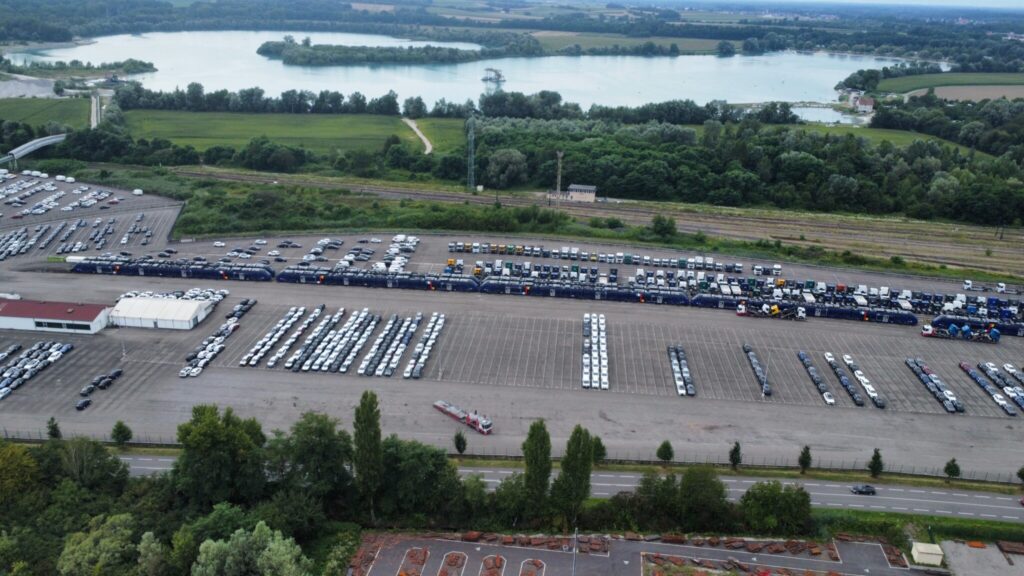

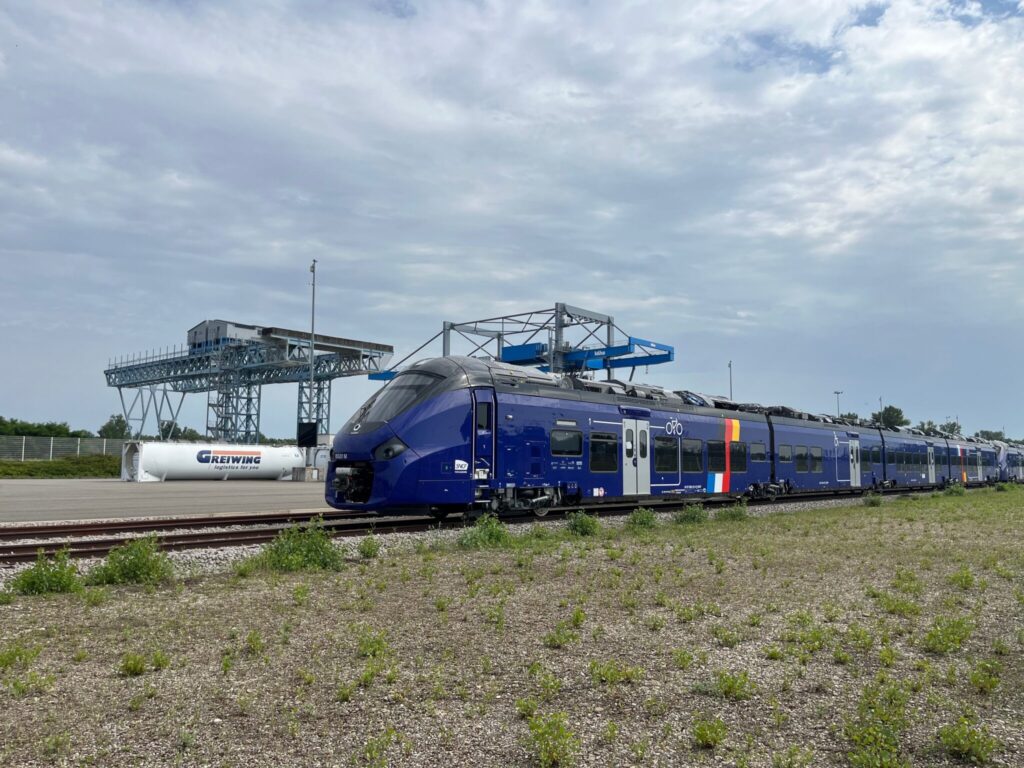
A further 8 trains were at the ex-Alstom (now CAF) plant at Reichshoffen on 1 August – 4 to the south of the plant (Google Maps), and 4 more either alongside or within the main plant (Google Maps)
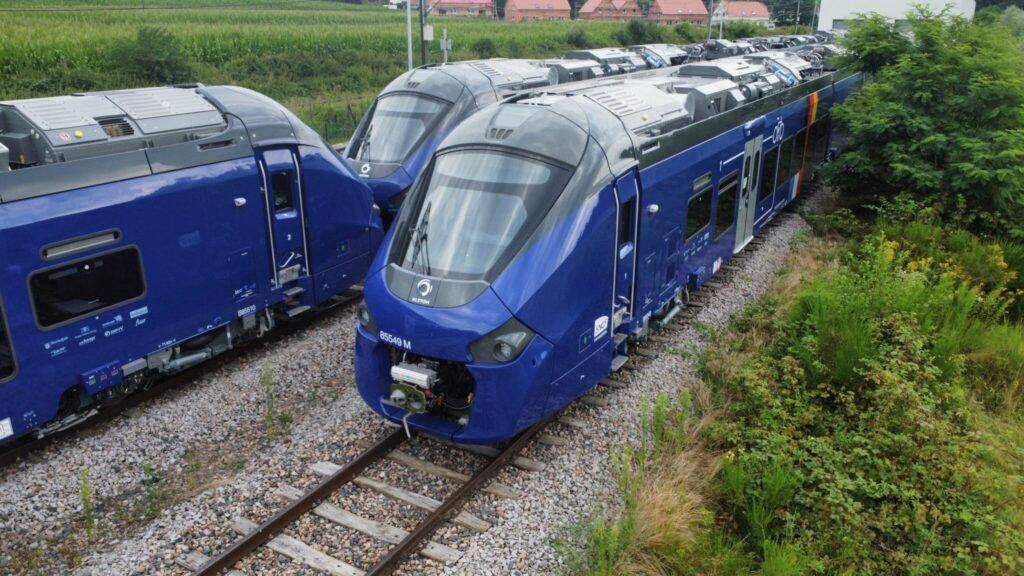
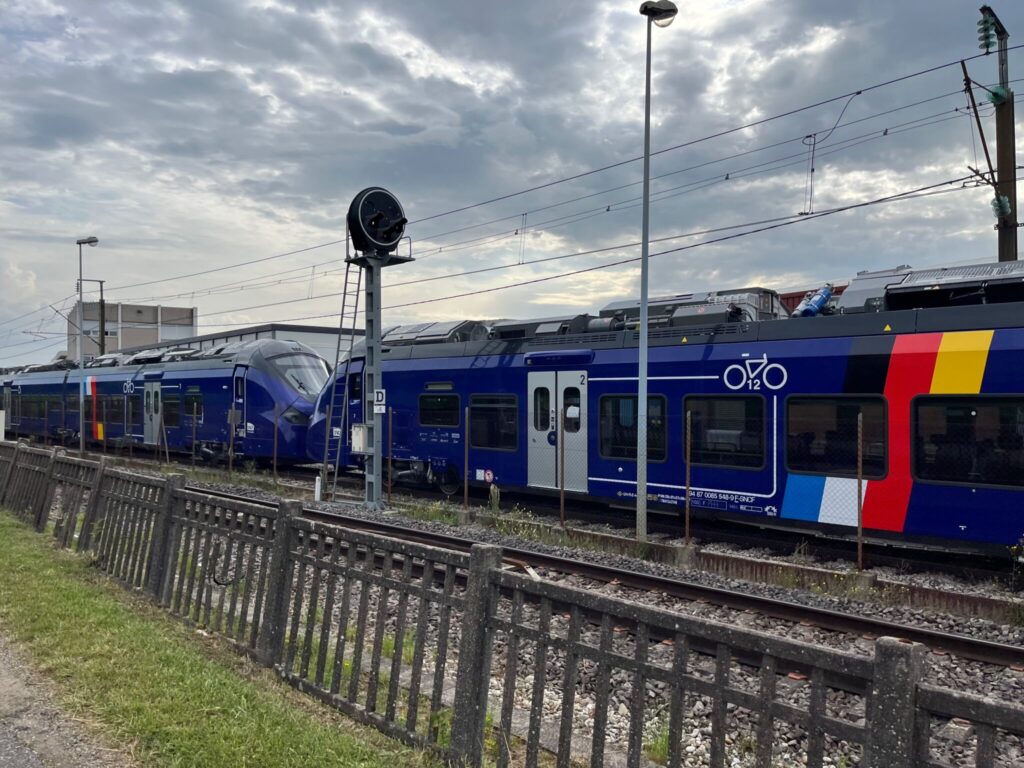
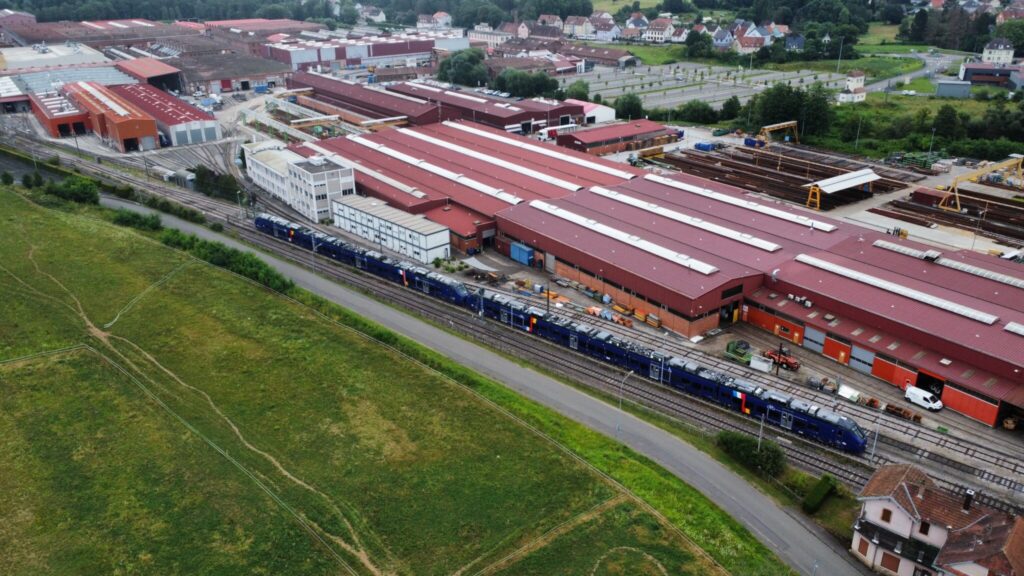
And a final 2 trains were at the SNCF Technicentre Alsace (Google Maps) – also 1 August
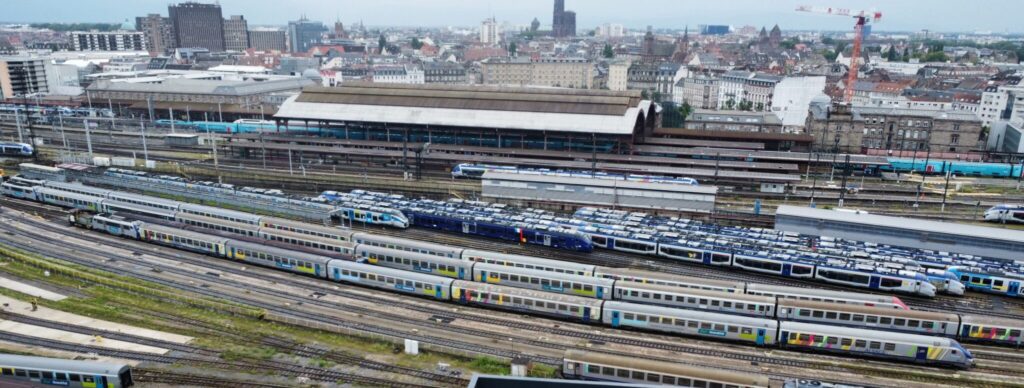
So that means at least 23 of the fleet of 30 trains is complete.
So what should be done with these trains?
The old version of the Zweckverband ÖPNV Rheinland-Pfalz Süd page cited above has the right idea – these trains should be deployed on existing cross border routes as soon as possible, to ease the rolling stock capacity problems, and also eliminate diesel traction on electrified routes.
First priority would be to run Régiolis on Strasbourg – Offenburg, where capacity on the existing diesel railbuses is far too limited, and these run on a line that is electrified throughout. Régiolis would replace both SNCF and SWEG railbuses here.
- DB 628 DMU used Wörth (Rhein) – Lauterbourg
- SWEG RS1 railbus used Strasbourg – Offenburg
- SNCF X 73900 railbus used Strasbourg – Offenburg and Saarbrücken – Forbach
A similar solution would be available right away for Saarbrücken – Forbach, where Régiolis would replace X 73900 on an electrified line, even with the possibility of running as far as Metz right from the start.
Wörth (Rhein) – Lauterbourg has a different issue – the DB 628 DMU used there is not disabled accessible and has no air conditioning, so running a Régiolis here would be a major step forward for all passengers.
Mulhouse – Müllheim (Baden) would also benefit from new trains, but a driver shortage there means all trains are replaced by buses at the moment, so Régiolis there should only happen once the other lines are fixed. Winden (Pfalz) – Wissembourg runs with Talent DMUs that are passable for now, Saarbrücken – Sarreguemines is ok with the tram and a few trains for now, Perl – Thionville has a weekend only service so let’s not get carried away asking that gets stepped up, and let’s not dream for Niedaltdorf – Bouzonville currently.
So for the three priority borders, are there enough Régiolis trains to cover those services: clearly and obviously YES. So that is how a temporary solution should look – run the new trains on those lines as soon as possible. This is the short term priority – make this happen.
FAQ
Are these trains too complex?
Two electric systems, and diesel, is a common combination in France – even the AGC trains (predecessor of the Régiolis) had this from 2009 onwards. Régiolis bi mode trains have been in service since 2014. The only difference with the cross border Régiolis is the replacement of 1.5kV dc with 15kV ac, and 15kV ac has been used successfully on the Léman Express units. So no, ultimately, I see no reason why these trains should be any more complicated than hundreds of others already in operation in France and Switzerland.
Is this all actually a problem of rolling stock authorisation instead?
I don’t think so, but I cannot be 100% sure, because not all the necessary information is available in public. I can find no information about the approval of this Régiolis variant in ERATV, although there is a fiche for the Léman Express ones. I however cannot see how a reasonably simple 160km/h train, where a similar version was approved, can be encountering major headaches in terms of approval – not least as they have now had 3 years to iron out any kinks. There is no reference in any news story anywhere to approval problems being the reason for the delays. Also given there were pre-series trains (in 2021) and then series production (from 2023), I cannot imagine the latter happening if there were some major technical headache still to overcome.
Do you have any close up pictures of the trains?
Yes. Click to enlarge each!
[Update 7.8.2024]
SNCF Grand Est sent out this marketing email today, recruiting drivers for France-Germany routes:


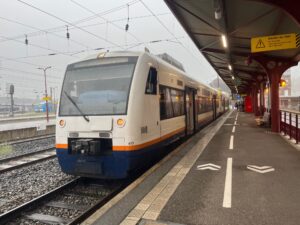

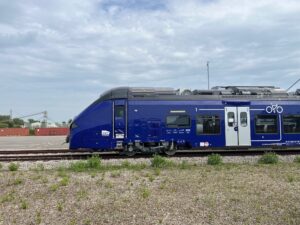
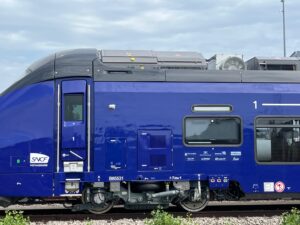
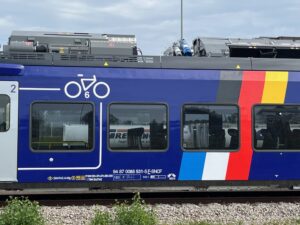
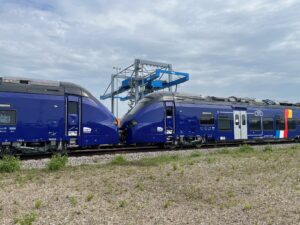
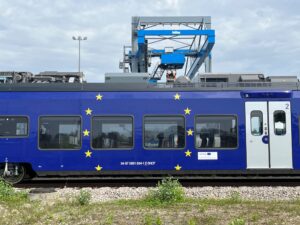

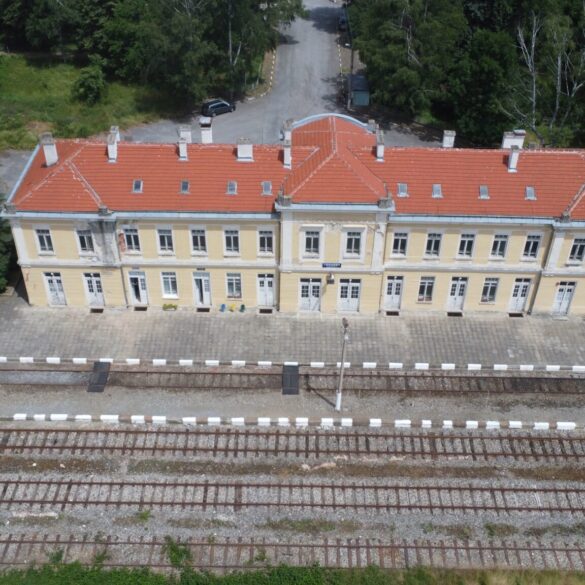
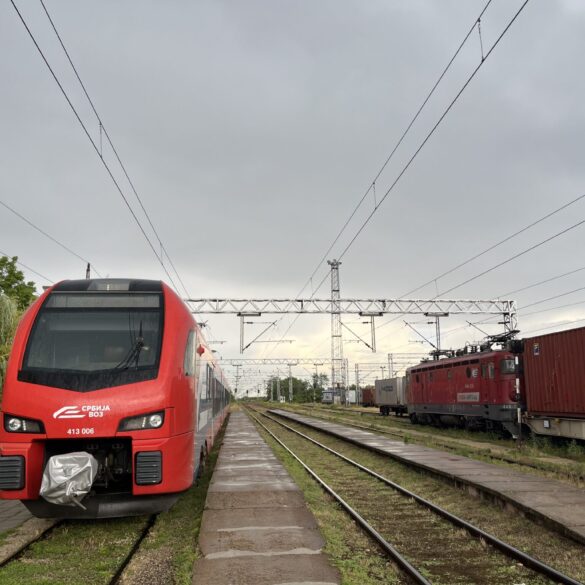
You leave out the obvious problem with running the trains now: Who would run them? And what would happen if the current operator doesn’t win the tender?
If, for example, they would be given to SNCF and SWEG to run between Strasbourg and Offenburg, both these companies (especially SWEG) would need to train their staff to operate the new rolling stock. And if they don’t win the tender, all that effort and financial risk would have been wasted. And no operator is willing to take this risk.
Furthermore it can be seen as an unfair advantage (or even favouritism from the state/department) in the tender if some of the operators that bid on it will already have access and experience with the vehicles while other did not.
Think about this a little. When such services have first been put to tender in the past, drivers transfer to the new operator. Could easily be done here. Plus these Régiolis are very similar to those already operating in France – how much extra training are SNCF drivers going to need?
Plus – if you take a step back – even going for this as part of the Régiolis framework contract could have been considered a bad idea, as it massively favours SNCF to win an eventual tender as they have drivers for these trains but no one else does.
Oh and by the way, even were your point a show stopper, what’s your solution? Leave the trains rusting?
Thanks Jon for your excellent investigations!
SNCF and SWEG are presenting an offer with a common company for both tenders (Metz and Strasbourg), so if the winner is proclaimed shortly I should not be an issue ;). The transfer of drivers will not even cover 1/3 of the planned cross border trains if everyone accepts to be transferred because the amount of drivers transferred is calculated on the existing train service at the launch of the tender 3 years ago ( you have to take into account that you have to be over 50% of the workload to be obliged to in France, that’s another difficulty if the new company doesn’t offer proper working conditions)
Ah now that is a way forward I’d not expected! That’s very useful information. And it would solve deployment of Régiolis on Saarbrücken – Forbach (- Metz), Strasbourg – Offenburg and maybe even Müllheim (Baden) – Mulhouse right away.
But it raises serious questions too. First, will anyone else seriously bid when faced with this? Who could even bid? Would DB Regio, or the likes of Go-Ahead (Arvenio) or Transdev even try? Also I know there have long been concerns about SNCF’s high costs in BaWü for a long time – is all that just brushed under the carpet? Plus – more fundamentally – to make a whole tender construct and then end up with pretty much the same outcome is… well, a little strange.
This would also be consistent with this news sent to me by a Mastodon follower @onterof where DB Regio has been given a contract extension for existing services to Wissembourg and Lauterbourg.
My only comment is that by a huge coincidence I found myself on a SWEG from Strasbourg to Offenburg yesterday, around 11.00, and it was absolutely rammed. I was on a cross-border journey from Colmar to Karlsruhe which had all the things you’ve tried to highlight, including booking the whole trip with three legs on the Bahn Navigator app, paying for it, and then gettting…nothing, nix, nada. No evidence of purchase whatsoever in my mail or on the app. I re-booked it in the morning by using the SNCF site for the first leg to Strasbourg. Apparently I have to wait to see if I get my €55 back from DB without any fuss. Standing on that SWEB train, hemmed in by bikes, it was no comfort thinking of your project and that this was exactly why you do it. Lets hope indeed for a good new TC who listens and acts.
From what I understand (being an SNCF driver at Strasbourg depot), the current plan is to keep doing a few tests until October 2024, and then they want these trains to lend a hand to the normal regional services out of Strasbourg (keep in mind that the Grand Est region is still short on trains [and drivers]). So they wouldn’t be rusting away. They would not go just yet on cross-border services but at least they would be put into action, whether coupled to another « standard unit » or on their own.
I don’t think much formation will be required, maybe a presentation of the changes on the driving desk, and we’ll probably be given vague information on performances which might be slightly different than on standard units. But I’m guessing that will be pretty much all.
I think this way they also expect SNCF to take the fall for all the potential faults these new units might suffer from at the beginning. So that when a tender wins the bid, they will get trains that are already run in.
Hi Jon,
Thank you very much for this article.
Do you have a french translation ? I’m pretty sure I read this article in french but can’t found it anywhere.
Thank you.
No, sorry, I have not made a translation.